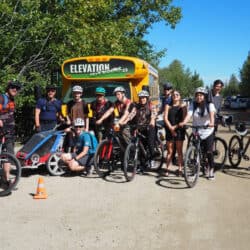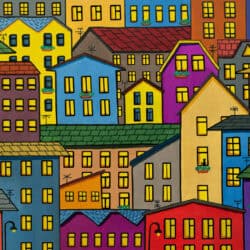More than three decades after the Mohawk Resistance at Kanesatake, the activist, artist, and filmmaker who was on the front lines doesn’t see much progress in Canada’s treatment of Indigenous Peoples. She hopes her new book will help educate Canadians.
Indigenous activist, artist, and filmmaker Ellen Gabriel had just graduated from university 35 years ago when she was thrust on the front lines of a dispute that would make headlines around the world and eventually become widely known as the “Oka Crisis.”
What started as the Mohawk community fighting to save their ancestral lands – a sacred-to-them pine forest and graveyard in Kanesatake, Quebec, known as “The Pines” – from a developer’s plans to turn them into part of an expanded golf course, would lead to a 78-day armed standoff and bring global attention to Indigenous rights and land claims in Canada.
On July 11, 1990, Quebec provincial police officers armed with assault rifles arrived at the barricade erected by land defenders. Over the next few weeks, they would be joined by the Royal Canadian Mounted Police and the Canadian Armed Forces as the increasingly tense standoff left a provincial police officer dead and hundreds of Mohawk civilians injured. The standoff would last until September 26, when Mohawk warriors surrendered. The federal government would eventually purchase the disputed land to prevent further development, yet that land has never been transferred to the original custodians.
For many Canadians, that summer was a wake-up call. It put the fight for Indigenous rights front and centre and made people realize colonialism was very real.
Ellen Gabriel
As a trilingual speaker, Gabriel was forced into the public spotlight as her community’s official spokesperson during the dispute. “For many Canadians, that summer was a wake-up call,” she says. “It put the fight for Indigenous rights front and centre and made people realize colonialism was very real.”
More than three decades later, mainstream media and history books refer to the standoff and blockade as the Oka Crisis, but Gabriel refers to the events as the Siege of Kanesatake and Kahnawake. “It wasn’t a crisis for Oka,” she says. “Oka caused the crisis. We were the ones occupied.”
How history is remembered and taught is a poignant reminder of whose perspective is often prioritized. As the Mohawk community fought developers; municipal, provincial, and federal politicians; and law enforcement over the protection of their lands, mainstream media at the time painted them as dangerous terrorists, even though the community was only defending its sovereignty and right to self-determination.
Criminalizing Indigenous land defenders, Gabriel says, has always been part of the colonial playbook.
In her new book, When the Pine Needles Fall: Indigenous Acts of Resistance, a series of conversations between Gabriel and settler historian Sean Carleton discussing the crisis, Indigenous resistance, and decolonization, she writes about how “media mostly focused on the men in camo gear and ski masks holding guns,” instead of the role Indigenous women played and continue to play in Indigenous resistance. “They focused on criminalizing the community instead of paying attention to the real culprits: the federal, provincial and municipal governments, and the original land thieves, the Saint-Sulpice Seminary.”
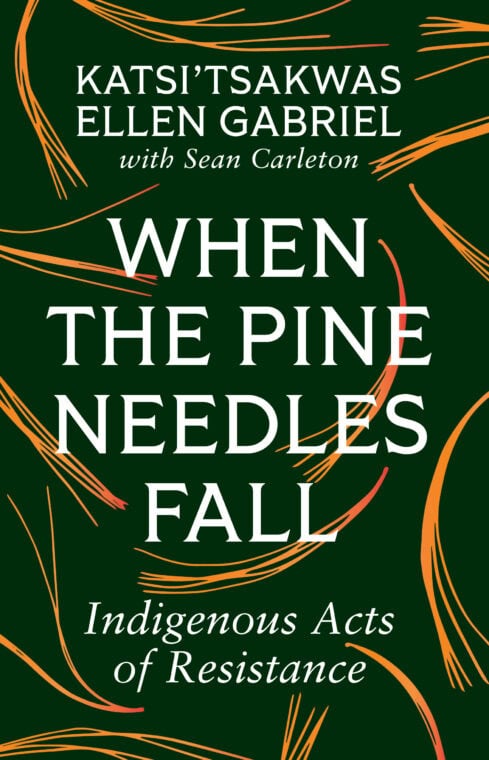
Gabriel wrote the book because, she says, she “wanted to reclaim the narrative.” The focus on “Mohawk warriors” in camo gear and inconvenienced motorists annoyed by blocked bridges made it easier, she tells me, to justify the use of force. It incited fear and hatred of Indigenous resisters, instead of focusing on their land struggle and the root causes of why things had escalated to this point.
The Indian Act was designed to usurp the role of the women because we hold title to the land. Not the men.
Ellen Gabriel
Over the course of her lifelong activism, Gabriel has served as president of Quebec Native Women Inc. and has spent decades advocating for justice for missing and murdered Indigenous women. She wants to set the record straight about who was really in charge during the armed standoff. “The women were really the leaders of the movement,” she says. “The men took their guidance from us. In our culture, the women are the clan mothers; they’re the ones who declare war and assign a war chief. We were practising our laws and taking back that role of women in regard to governance and decision-making processes. Laws that have been maligned by colonial structures like the band council. The Indian Act was designed to usurp the role of the women because we hold title to the land. Not the men.”
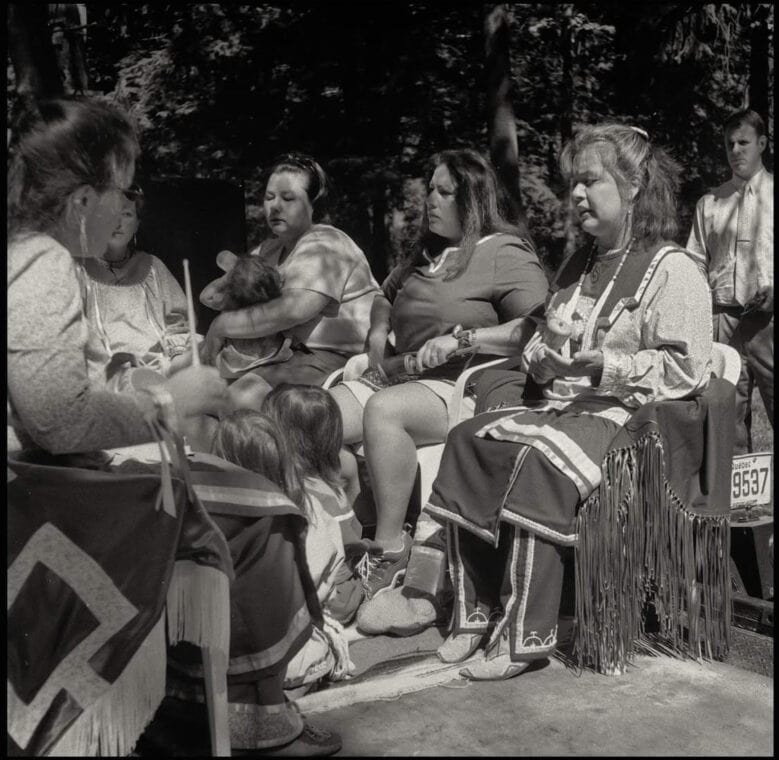
In her book, Gabriel describes the moment when police first approached the resisters. “When we (five women at first, joined by nine others later, 14 women) approached the front barricade,” she writes, “the police yelled at us, saying they wanted to speak to our leader. We looked at one another and thought, ‘We are the leaders.’”
‘No reconciliation without truth-telling’
As Canada celebrates National Indigenous History Month, Gabriel, a longtime fighter for land reclamation and language revitalization, doesn’t see much progress in Canada’s treatment of Indigenous Peoples. “The standoff helped create that understanding of the imbalance of colonization and what it creates,” she says, “but I think the government just learned different ways to be sneakier about extinguishing our rights to our land.”
The more Gabriel learned about Indigenous struggles, the more determined, she says, she became to be part of the movement to address centuries of land theft and ongoing colonization in her community, first by the French, and then by the British and Canada.
“What we did in 1990 was such an honourable and righteous thing,” Gabriel says, “and many people didn’t know if we would survive. But when I look at what’s happened since . . . I still have hope, but we’re still losing land, and the government continues to create all sorts of excuses about why we don’t have rights on our traditional homelands.”
We’re still losing land, and the government continues to create all sorts of excuses about why we don’t have rights on our traditional homelands.
Ellen Gabriel
Gabriel hopes her book (which has also been translated into French) will help educate Canadians. “What happened 35 years ago is a really important part of Canada’s history,” she says. “If we’re going to talk about reconciliation, the most important thing to do is acknowledge the crimes and harms that were brought against us. You can’t have reconciliation without truth telling.”
Even after the Truth and Reconciliation Commission and its recommendations, and the Royal Commission on Aboriginal Peoples, progress is slow. “It’s just the status quo and a little bit more money,” Gabriel says. “But money won’t solve everything. We need to change minds. Because if you know the truth, maybe you’ll grow as a human. We still face a lot of racism.”
Gabriel believes education to be part of the solution for the racism and discrimination that Indigenous communities experience. “If Canadians understood there’s still an apartheid system here, maybe they would see things differently,” she says. “But colonization isn’t being taught in schools as something that’s currently taking place, and Canada doesn’t think of itself as a colonizer.”
Decolonization and reconciliation require education and discussion. “Ultimately,” Gabriel believes, “reconciliation is a Canadian responsibility.”
Restorative philanthropy and Indigenous communities
The concept of restorative philanthropy (rethinking traditional funding models and directing more resources and power to community, so that solutions can be community-led) is being increasingly discussed these days as it applies to reconciliation. How can we collectively repair harm done in the past and help support Indigenous communities to determine their own funding priorities and develop solutions that are culturally relevant to them and best meet their needs?
On the eve of the 35th anniversary of the Mohawk Resistance at Kanesatake, I ask Gabriel her thoughts on how best to improve the process of supporting the revitalization of Indigenous languages, cultures, and traditional practices that have long been threatened by assimilation policies, as well as how to best facilitate dialogue and collaboration between Indigenous communities, various levels of government, and other organizations to advance reconciliation.
“Land back is probably a good step forward,” Gabriel says. “You can fund the language and cultural events, but if you don’t have the land, then your culture is shrinking. It’s the essence of our struggle. The land is everything to me.”
Infrastructure is always needed. “The longhouses will never ask the government for money, because,” she says, “it’s like asking Donald Trump to help Canada.”
Most Indigenous communities are also concerned about sustainable development and so they continue to push back against colonial and capitalist development. Indigenous people worldwide continue to be leaders in the fight against the climate crisis. “Food sovereignty and seed banks are also really important,” Gabriel says. “Especially given today’s state of the world and the impact of climate change on the land and on things that are indigenous to this part of the world.”
The longhouses will never ask the government for money, because it’s like asking Donald Trump to help Canada.
Ellen Gabriel
As for efforts to protect Indigenous languages, Gabriel points to the Indian Act across Canada and Bill 101 (and its updated version, Bill 96 in Quebec, which legislates French as the official language of the province) as deterrents to the promotion and protection of their own identity as Indigenous people. “I speak three languages,” Gabriel says, “and every time I speak English someone will say ‘Ici c’est Québec, on parle français.’ (This is Quebec, we speak French here.) This is my homeland; I don’t have to speak your language.”
While more than 60 distinct Indigenous languages and dialects are spoken in Canada, many of them are considered endangered because of colonial policies. “We’ve lost so many first-language speakers,” Gabriel says. “The language programs started with Indigenous women cutting out magazine pictures to associate the words with the photo. It wasn’t because of the good graces of any government that the programs exist today.”
Gabriel says part of the problem is that there’s more of a focus on project-based funding rather than sustainable funding that will carry communities long-term. “People need to get paid,” she says. “You need to have an established workforce that’s able to provide that linguistic or cultural service, and you can’t do that on project-based funding. The people who have this precious knowledge are too busy writing reports.”
Moving forward with an eye on the past
At the end of the day, Gabriel believes that reconciliation must translate into tangible actions. “Are Canadians helping to support the organizing,” she asks. “Are they contributing to legal defence funds, or is this just ‘colonization repackaged’”?
Philanthropic projects that help fund and promote Indigenous art are also a way of honouring the truth. As a visual artist and filmmaker, Gabriel understands the power of creative expression. “Art is an important tool to use in educating people,” she says. “It’s non-threatening. You can decide to look at it or not. From literature to visual arts, dance, film, art has always been used as part of the education for the masses, and it’s no different for Indigenous people.”
Gabriel points to the example of Cree artist Kent Monkman, well known for depicting the brutality of colonization. “When people see his art,” she says, “it makes them want to learn more about what they’re looking at. Art is an important conversation starter.”
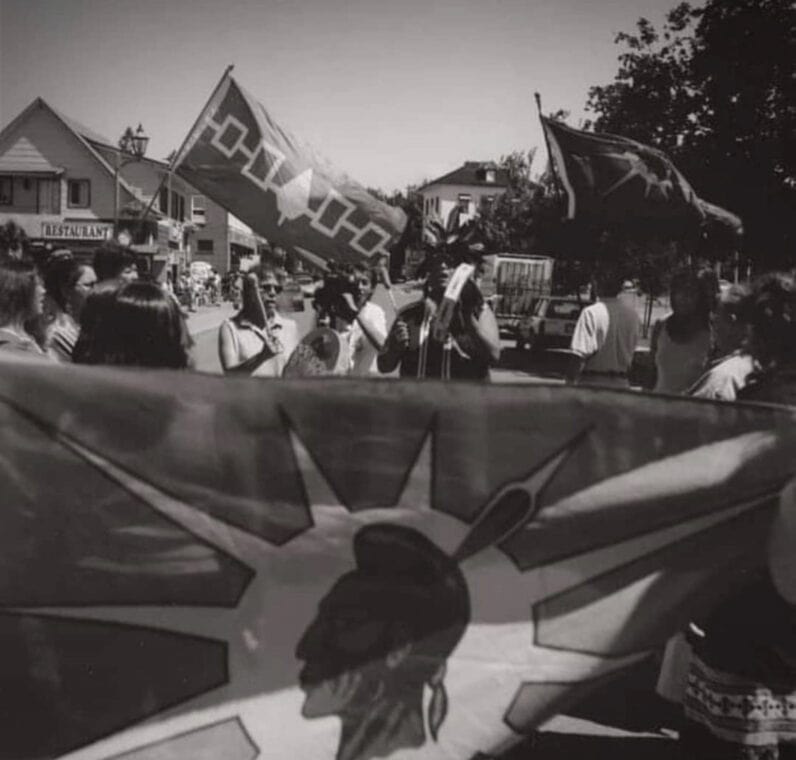
Art is also a way of sharing what one values. “I always wanted to learn about the richness of my culture,” Gabriel says, “not just focus on the dysfunction created by colonization and genocide.”
And somewhere between culture and colonization is continued resistance. Thirty-five years after the Siege of Kanesatake and Kahnawake, the fight carries on. “All we were doing was peacefully blocking a secondary dirt road to inform people about our land struggle and the reason why we opposed the golf course expansion,” Gabriel writes in When the Pine Needles Fall. “We never blocked a major highway until we were attacked by the [Sûreté du Québec].”
“Those 78 days changed the way I saw Canada,” she tells me. “It was a steep learning curve for me that summer.”
